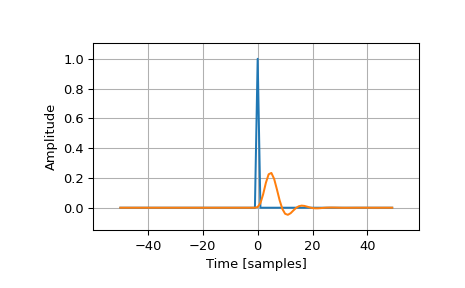scipy.signal.
unit_impulse#
- scipy.signal.unit_impulse(shape, idx=None, dtype=<class 'float'>)[source]#
单位脉冲信号(离散狄拉克函数)或单位基向量。
- 参数:
- shapeint 或 int 元组
输出中的样本数(1-D),或表示输出形状(N-D)的元组。
- idxNone 或 int 或 int 元组 或 ‘mid’,可选
值为 1 的索引。如果为 None,默认为第 0 个元素。如果
idx='mid',则脉冲将以所有维度中的shape // 2为中心。如果为 int,则脉冲将位于所有维度中的 idx。- dtype数据类型,可选
数组所需的数据类型,例如
numpy.int8。默认为numpy.float64。
- 返回:
- yndarray
包含脉冲信号的输出数组。
备注
在数字信号处理文献中,单位脉冲信号通常由克罗内克 delta 表示。[1] 即,除了在第 \(k\) 个样本处为一以外,其他地方都为零的信号 \(u_k[n]\) 可以表示为
\[u_k[n] = \delta[n-k] \equiv \delta_{n,k}\ .\]此外,单位脉冲通常被解释为连续时间狄拉克分布的离散时间版本。[2]
参考文献
[1]“克罗内克 delta”,维基百科,https://en.wikipedia.org/wiki/Kronecker_delta#Digital_signal_processing
[2]“狄拉克 delta 函数” 维基百科,https://en.wikipedia.org/wiki/Dirac_delta_function#Relationship_to_the_Kronecker_delta
0.19.0 版本新增。
示例
第 0 个元素处的脉冲(\(\\delta[n]\))
>>> from scipy import signal >>> signal.unit_impulse(8) array([ 1., 0., 0., 0., 0., 0., 0., 0.])
偏移 2 个样本的脉冲(\(\\delta[n-2]\))
>>> signal.unit_impulse(7, 2) array([ 0., 0., 1., 0., 0., 0., 0.])
2 维居中脉冲
>>> signal.unit_impulse((3, 3), 'mid') array([[ 0., 0., 0.], [ 0., 1., 0.], [ 0., 0., 0.]])
使用广播在 (2, 2) 处的脉冲
>>> signal.unit_impulse((4, 4), 2) array([[ 0., 0., 0., 0.], [ 0., 0., 0., 0.], [ 0., 0., 1., 0.], [ 0., 0., 0., 0.]])
绘制 4 阶巴特沃斯低通滤波器的脉冲响应
>>> imp = signal.unit_impulse(100, 'mid') >>> b, a = signal.butter(4, 0.2) >>> response = signal.lfilter(b, a, imp)
>>> import numpy as np >>> import matplotlib.pyplot as plt >>> plt.plot(np.arange(-50, 50), imp) >>> plt.plot(np.arange(-50, 50), response) >>> plt.margins(0.1, 0.1) >>> plt.xlabel('Time [samples]') >>> plt.ylabel('Amplitude') >>> plt.grid(True) >>> plt.show()
